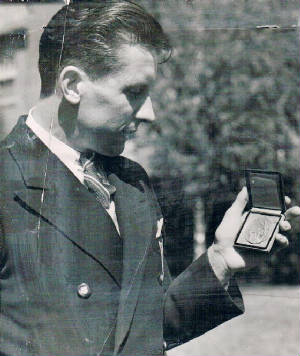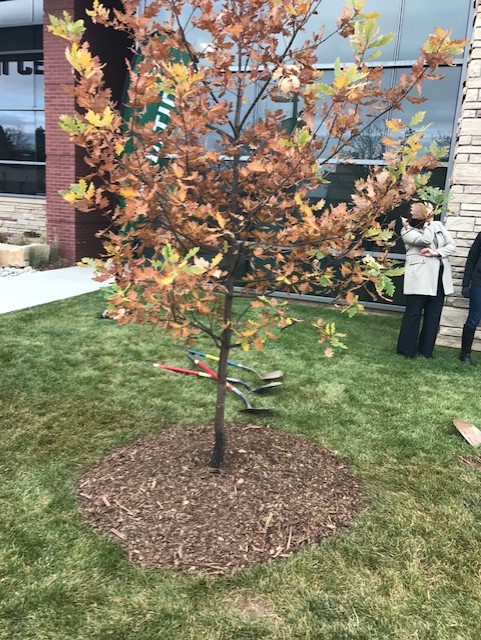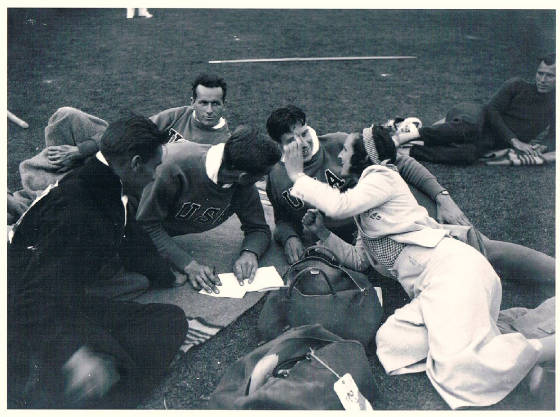|
|
HOMEInstitutional Knowledge commentariesBioFilm rights, Screenplays, RepresentationOlympic Affair: Hitler's Siren and America's HeroHORNS , HOGS, AND NIXON COMINGThird Down and a War to Go'77: DENVER, THE BRONCOS, AND A COMING OF AGETHE WITCH'S SEASONPLAYING PIANO IN A BROTHELMarch 1939: Before the MadnessPress CredentialsThe OregonianThe Sporting NewsESPN.comDenver PostGreeley TribuneEarthquake at the World SeriesHoneymooners Meet the Boys of SummerTommy Lasorda, the Spokane Indians, and My Summer of '70Breaking my own rule. With the first person to walk on the moonLeila Morrison: She came ashore at Normandy, too ... and kept gpingEdna Middlemas: She was in the Room where it happened at Yalta ... and earned the Bronze StarElmer Gedeon, Michigan and Washington SenatorsA Year with Nick Saban before he was NICK SABANHorns, Hogs, and Nixon Coming Excerpt: James Street: Wishbone WizardHorns, Hogs, and Nixon Coming, Excerpt: July 1969 ... and beyondHorns, Hogs, and Nixon Coming excerpt: Right 53 Veer PassHorns, Hogs, and Nixon Coming: The Greg Ploetz SagaHorns, Hogs, and Nixon Coming: 20th Anniversary of ReleaseThird Down and a War to Go genesis: Grateful for the Guard, Jerry FreiThird Down and a War to Go: PrologueThird Down and a War to Go: Mosquito BowlThird Down and a War to Go: Saluting Madison GillaspeyThird Down and a War to Go Excerpt: Ohio State vs. WisconsinThird Down and War to Go: The death of Dave SchreinerThird Down and a War to Go Excerpt: Minnesota gameThird Down and a War to Go: Bob BaumannThird Down and a War to Go: Badgers Mark Hoskins and Don Pfotenhauer. The POW Experience'77: Randy Gradishar'77: AFC Title Game'77: RIP, Joe Collier'77: RIP, Otis Armstrong'77:Red Miller'77: Louis Wright'77: Broncos at Raiders'77 excerpt: John Ralston'77 excerpt: Barney ChavousThe Witch's Season: Air Force Game, Bitter Protest, a Single ShotThe Witch's Season's circuitous journeyThe Witch's Season: UCLA Game, weed, smoke, turmoilThe Witch's Season: Saluting Tom GrahamPlaying Piano Excerpt: Rocky HockeyPlaying Piano Excerpt: Leonard vs. Hearns vs. HaglerOlympic Affair Genesis: Glenn Morris OakOlympic Affair: Chapter 1, Leni's VisitOlympic Affair: Chapter 15, Aren't You Thomas Wolfe?Olympic Affair: From internationally celebrated Olympic hero to Lions castoff ... in 4 yearsMarch 1939: IntroductionMarch 1939, Excerpt: The StartersMarch 1939 Excerpt: First NCAA Title GameSave By RoyOmnibus profile: Lt. Col. John Mosley, Aggie and Tuskegee AirmanLt. Col. John Mosley BoulevardCSU retires Lt. Col. John Mosley's No. 14They Call Me "Mr. De": The Story of Columbine's Heart, Resilience and RecoveryA Selection of Terry Frei's writing about World War II heroesSmoke 'em inside: On Ball Four and Jim BoutonAll about The Code: Steve Moore and Todd BertuzziPhil Guardado and High Plains Honor FlightJon Hassler, Terry Kay and other favorite novelistsKids' sports books: The ClassicsBig Bill Ficke's Big HeartBob Bell's Food For ThoughtIrv Brown is on AssignmentIrv Moss, Colorado ClassicAnother Richard MonfortShadowing Derrick WebbLewis "Dude" Dent, Colorado A&M (State)Perry Blach, Colorado A&M (State)Bednar paid his dues ... and then someHeroic Buff Bob Spicer: "That's how I lost my eye"Salute to Pierre Lacroix, who built Colorado's first championsHockey in Stalag Luft IIIJoe Sakic interviewFrench Legion of Honor MedalPierre Lacroix Celebration of LIfeRIP, Bob Newland: A great Duck and loyal friendWhen the Broncos spent their summers in GreeleyUvalde ignored the lessons of ColumbineCatching up with Frank DeAngelis about gunsEx-Columbine principal Frank DeAngelis: "It's got to stop."Chris Drury, Little LeaguerEx-Av Andrei Nikolshin's Ukraine roots: His father survived invasion, gulags, coal mines, moreRIP, Ron Earley (1950-2022)Bryce Harper, phenomOn "My Fair Lady"On "To Kill A Mockingbird": Book, movie, playLes Miz still is thrilling the 10th (or so) time aroundMSU Denver: Introduction
|
October 27, 2017 CSU Fetes Glenn Morris With Olympic Oak Tree

FORT COLLINS -- This was the Glenn Morris Oak Tree Sequel.
On Friday afternoon, outside the Iris and Michael Smith Alumni Center at the northwest corner of the new stadium, Colorado State planted an oak tree to honor Morris, the 1936 Olympic decathlon champion from tiny Simla, 49 miles northeast of Colorado Springs.
Before winning gold at Berlin and becoming briefly one of the most famous athletes in the world, Morris was a football and track star, plus the student body president, at what then was known as Colorado A&M.
The main speaker during the ceremony Friday was CSU's Tony Phifer, a former Coloradoan sports writer whose self-described "obsession" to track down the oak tree Morris was presented in Berlin -- to go with the gold medal -- started a chain of events that, indirectly, led to me writing Olympic Affair. It's why I dedicated the book to Phifer and Morris Ververs, the long-time educator in Simla who in essence was the trustee of Morris' legacy.
Here's the beginning of that Afterword (touched up to avoid repetition):
In May 2010, I heard from former newspaperman Tony Phifer, a senior writer for Colorado State University's Division of External Relations. Tony and I serve together on the selection committee for the Colorado Sports Hall of Fame. Tony suggested that an upcoming ceremony on the CSU campus in Fort Collins might be in my wheelhouse for a Denver Post story. CSU was going to plant an oak-tree seedling to salute Glenn Morris.
Why an oak tree?
Tony explained that the German Organizing Committee officials handed out seedlings for the gold medalists to take home and plant, preferably in their hometowns or at their universities. As the trees grew, they would be reminders of the Olympic spirit. Less trumpeted was that they also could be considered links to mythology's Thor and his "Donar Oak." Tony found a picture that proved Morris presented his tree to CSU president Charles Lory in September 1936. By the 21st century, though, nobody seemed to know where it had been planted, if it had been planted at all, or what happened to it. Tony wrote stories for university publications on the mystery, and he hooked up with Don Holst, the 1968 Olympic men's decathlon coach and an Olympic historian who lives in Chadron, Nebraska. Holst sought to trace the few known surviving Berlin trees, produce second- and third-generation oak seedlings, then plant them at various sites tried to the 1936 Olympians around the country. In May 2010, it was CSU's turn -- in honor of Morris.
In advance of that 2010 ceremony, I visited Simla, meeting with Ververs and even holding Morris' gold medal, and did considerable additional research on Morris. I pre-wrote an extensive feature on Morris that I would touch up while attending the ceremony for publication in The Denver Post. What I had came across was fascinating, including that controversial German filmmaker Leni Riefenstahl and Morris had an affair tied to the making of her acclaimed documentary, Olympia. Morris told others about it, including his brother and A&M booster Sparks Alford, and Riefenstahl wrote about it in her 1987 autobiography. A half-century after the affair, she stunningly admitted that she, a manipulative woman accustomed to getting her way, was crushed when Morris declined to remain in Germany, or return soon, to be with her and act in German films. Instead, he soon married his college girlfriend and embarked on a brief, unsuccessful stint in Hollywood, including portraying Tarzan in the dreadul Tarzan's Revenge. After doing that story, I realized I had just scratched the surface, and plowed on in the research and writing -- and two years later, Olympic Affair was published. house on the east side of the campus after Morris. It seemed only right to find a way to honor Morris at the new stadium and that's what Friday was all about. The tree planted near the field house seven years ago is not particularly robust, but it turned out that Tim Buchanan, the city of Fort Collins' forester, also had obtained two additional oak saplings of the same lineage from Holst seven years ago, and one had grown into a healthy, if still developing tree. Buchanan donated it to CSU, and the decision was made to plant it at the stadium in Morris' honor.
Before the ceremonial first shovels and then the replanting of the tree, Phifer outlined the Morris story in his turn at the microphone, including the Olympic champion's stay at A&M/CSU. Then he brought up the oak-tree saplings, pointing out that Morris had remained in Europe after the Games competing in other meets at the behest of the USOC. (He also returned to Berlin for supplemental Olympia filming with Riefenstahl.)
"Then he was back on the ship for another week, and so he carried this seedling with him for all this time, and I started to think, 'Where would it be at CSU and where would they have planted it?'" Phifer said. "I was still at the Coloradoan at the time, writing for the newspaper, so I started looking for the tree around the Oval, which was really the only part of campus that existed back then. I couldn't find anything that resembled a tree that would be the right size, the right type. I looked at every tree over there ... Then I started doing some research in other ways. I went to the Morgan Library to start looking for old copies of the Collegian and I was really getting frustrated because I couldn't find any information about this tree."
Then came the discovery.
"Finally, this one day I was just flipping through these pages and I really wasn't paying attention and, voila ... "
He then pointed at an easel to his right, where the picture of Morris presenting the sapling to President Lory was displayed.
"... that photo appeared on the front page of the Collegian. And I said, 'Oh, my God, the oak tree made it to Fort Collins, made it to campus.' That me even more crazy about this story. In fact, my wife (Kathy), who is right over here, one day looked at me and said, 'You know what you are? You're obsessed. You're obsessed with this story. You're obsessed with this oak tree,' and I really kind of was. Then I wrote a story and that story was seen by the foresters at CSU and also Tim Buchanan, the forester for the City of Fort Collins. They agree with me, there was no Olympic oak on this campus. That became more and more of a mystery. What happened to this tree?"
Phifer noted that after he joined the CSU staff a couple of years later, he wrote another story on the mystery for the university's magazine, and it caught Ververs' attention. Ververs contacted Phifer and they talked about Morris, and then also a CSU alum in Chadron pointed out the story to Don Holst. That led to Holst offering an Olympic oak-tree seedling to CSU, and giving two more to Buchanan.
And that all led to Friday's ceremony.
Buchanan also spoke at the ceremony Friday, and he explained that Holst's seedlings, including the three he gave to CSU and Buchanan, were third generation in the lineage. The original seedling was the one given to 800-meter gold medalist John Woodruff and was planted in Connellsville, Pennsylvania. That tree flourished, and still is alive, and Holst -- who since has passed away -- took seeds from that tree and planted them near the U.S. Track and Field Hall of Fame on the Butler University campus in Indianapolis. The seedlings brought to Fort Collins are the offspring of that tree.
So while the mystery of what happened to the seedling Morris himself presented to CSU might never be solved, he now is honored with two offspring trees from from the Olympic crop on the campus. Morris' gold medal, transported from Simla to CSU five years ago, now is in a case inside the Alumni Center, honoring CSU's Olympians -- also including six-time gold medalist Amy Van Dyken. One part of getting the game-day football experience back to campus now can be saluting Morris and the tree outside the stadium, and seeing his gold medal in a tour of the Alumni Center.
Glenn Morris and Leni Riefenstahl. (National Archives. NA-242-HD-245-1.) |

